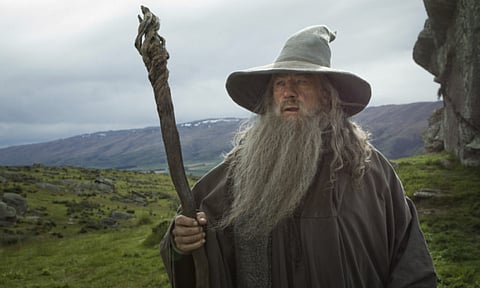Peter Jackson defends ‘Hobbit’ trilogy
Director said he was right to elongate children’s story into three epic movies

“The Hobbit” may be a shortish book about diminutive heroes, but Peter Jackson on Wednesday said he was right to elongate the children’s story into no less than three epic movies.
The New Zealand-born director has come under fire from some quarters for the trilogy, which opens on December 13 with the nearly three-hour-long first installment “The Hobbit: An Unexpected Journey.”
But Jackson said turning the original book into the sumptuous movie version of J.R.R. Tolkien’s fantastical Middle-earth required a slower approach. The initial plan was for two movies and soon that turned into three.
In Tolkien’s often “breathless” text, “very major events are covered in two or three pages,” Jackson told reporters in New York. “Once you start to develop the scenes and plus you wanted to do a little bit more character development,” the movie grew, he said.
To expand on the story, the filmmakers also dipped into Tolkien’s appendices to the “Return of the King,” the last of the “Lord of the Rings” trilogy that Jackson previously adapted to Oscar-winning films.
“The Hobbit,” which was screened for journalists in New York on Tuesday, sees the little Hobbit Bilbo Baggins, Gandalf the good wizard and 13 raucous dwarves embark on a journey bedeviled by a host of evil forces.
It is a prequel to the darker “Lord of the Rings,” introducing the main characters and plotlines that reappear through the entire saga. The cursed golden ring also makes its first appearance.
Screenwriter and co-producer Philippa Boyens said the different pace chosen for the movies compared to the book reflected the dynamics of working with actors.
“Great actors come to you for the material and if you give them very slight material, you’re just not going to get them. We wanted to write for these great actors,” she said.
British actor Ian McKellen, who reprises his “Rings” role as Gandalf in “The Hobbit,” batted down suggestions that the filmmakers were trying to milk the maximum profit out of Tolkien fans by splitting the “Hobbit” three ways.
“Anyone who thinks Peter Jackson would fall for market forces, instead of artistic imperatives, just doesn’t know him, doesn’t know the body of his work,” McKellen told reporters.
Ahead of the December 14 US premiere, critics are of two minds.
Jackson’s technical wizardry, using 3D and 48 frames a second, rather than the ordinary 24 frames, gets gasps of admiration, mixed with yawns about overkill.
“In Jackson’s academically fastidious telling, however, it’s as if ‘The Wizard of Oz’ had taken nearly an hour just to get out of Kansas,” The Hollywood Reporter said in a bruising review.
“There are elements in this new film that are as spectacular as much of the Rings trilogy was, but there is much that is flat-footed and tedious as well.”
Variety’s critic took aim at the overwhelming detail poured into 48-frames-a-second pictures.
“Everything takes on an overblown, artificial quality in which the phoniness of the sets and costumes becomes obvious, while well-lit areas bleed into their surroundings, like watching a high-end home movie,” Variety said.
There are bravura battle scenes choreographing Goblin hordes, fantastical caves, and James Bond-style narrow escapes from death for Martin Freeman’s Bilbo Baggins and his dwarf friends.
As in the three “Rings” movies, the natural settings of New Zealand are breathtaking.
But with so many strange beings attacking each other with swords, and so many arrows, rocks and bodies flying in 3D at the audience, the few intimately staged scenes focusing on just a couple characters can come as a relief.
When the action cut suddenly from the latest mass sword fight to a silent cave inhabited by Andy Serkis’s creepy character Gollum, journalists at Tuesday’s press screening broke out in a rare smattering of applause.
Sign up for the Daily Briefing
Get the latest news and updates straight to your inbox


